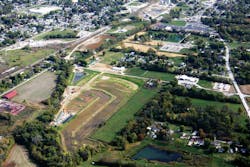Constructed Wetland for CSO Treatment Project
Cost: $26.4 million
Location: Washington, Ind.
Year: 2011-12-14
Size: 21-million-gal, 27-acre wetland; 4-million-gal storage tank
Owner: City of Washington, Ind.
Designers: Bernardin, Lochmueller & Associates Inc.
Contractor: Bowen Eng. Corp.; Koberstein Trucking; Gradex; Daylight Farm Supply; Capitol Electric; Integrity Eng.; MPC Containment Intl. LLC; Whaley Steel
Washington, Ind., a town of 12,000 in the southwest part of the state, was having serious problems with combined sewer overflow. The situation was so bad that just one-tenth of an inch of rain could produce a backup of gray, dirty, untreated water that ended up in nearby Hawkins Creek. A 2001 survey registered unsafe levels of biochemical oxygen demand, total suspended solids and ammonia.
Initially, the city enclosed the drainage ditches and creeks, which limited the runoff but still did not tackle the issue of water quality. The town conducted another study in 2002 to assess its options and found that proper treatment of runoff would cost almost $40 million. With that number only going up, and a median household income of $34,000, Washington was going to have to find another way.
Talks between town officials, eventual project designer Bernardin, Lochmuller & Associates, and the Indiana Department of Environmental Management resulted in a solution: a constructed wetland. The concept is fairly new—the Washington wetland, when completed, will be only the second of its kind in the U.S.—and the process is quite complex.
Storm water is filtered into a 4-million-gal storage tank and sent over to a treatment plant, while any overflow is carried to the wetland itself, which encompasses 27 acres. How long the overflow stays in the wetland is determined by a SCADA system. Following treatment, the effluent passes through an ultraviolet disinfection system before reaching Hawkins Creek, its final destination.
The new system has a variety of other features to assist with purification, including tools for fine particle removal, an underdrain system to allow dewatering for maintenance purposes, and a recirculation system to control soil moisture. Crews also planted foliage known for its ability to adapt to changes in water level and soil moisture. As a bonus, the wetland will remain saturated even in times of drought thanks to its depth and the natural geology of the area.
“Designing projects that help communities save money and protect the environment is a reward in itself,” said Project Manager Mark Harrison, P.E., LEED AP. “To be recognized for following your passion makes it all the better.”
Project Year: 2011-12-14Contractor: Bowen Eng. Corp.; Koberstein Trucking; Gradex; Daylight Farm Supply; Capitol Electric; Integrity Eng.; MPC Containment Intl. LLC; Whaley SteelDesigners: Bernardin, Lochmueller & Associates Inc.Owner: City of Washington, Ind.Location: Washington, Ind.Cost: $26.4 millionSize: 21-million-gal, 27-acre wetland; 4-million-gal storage tank